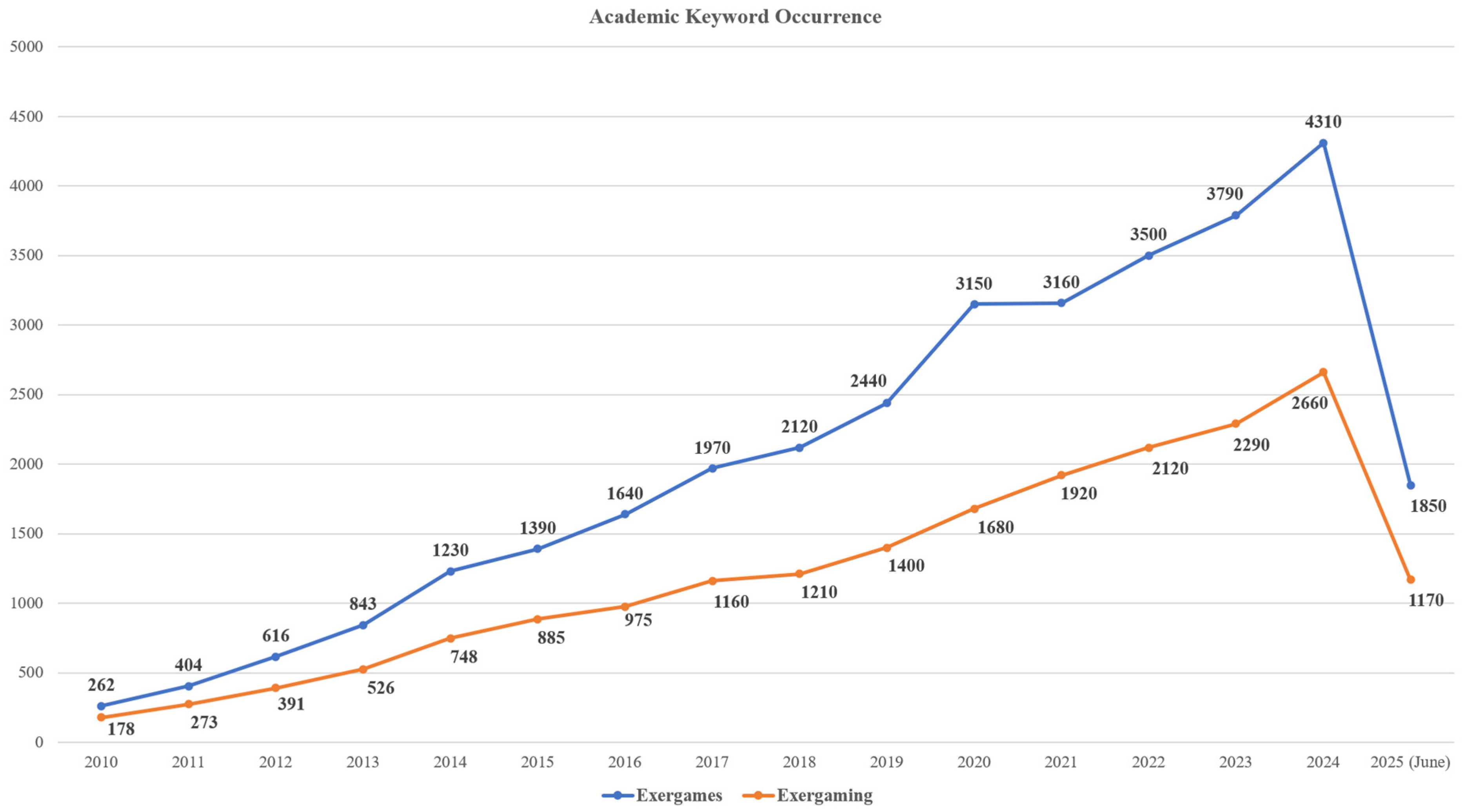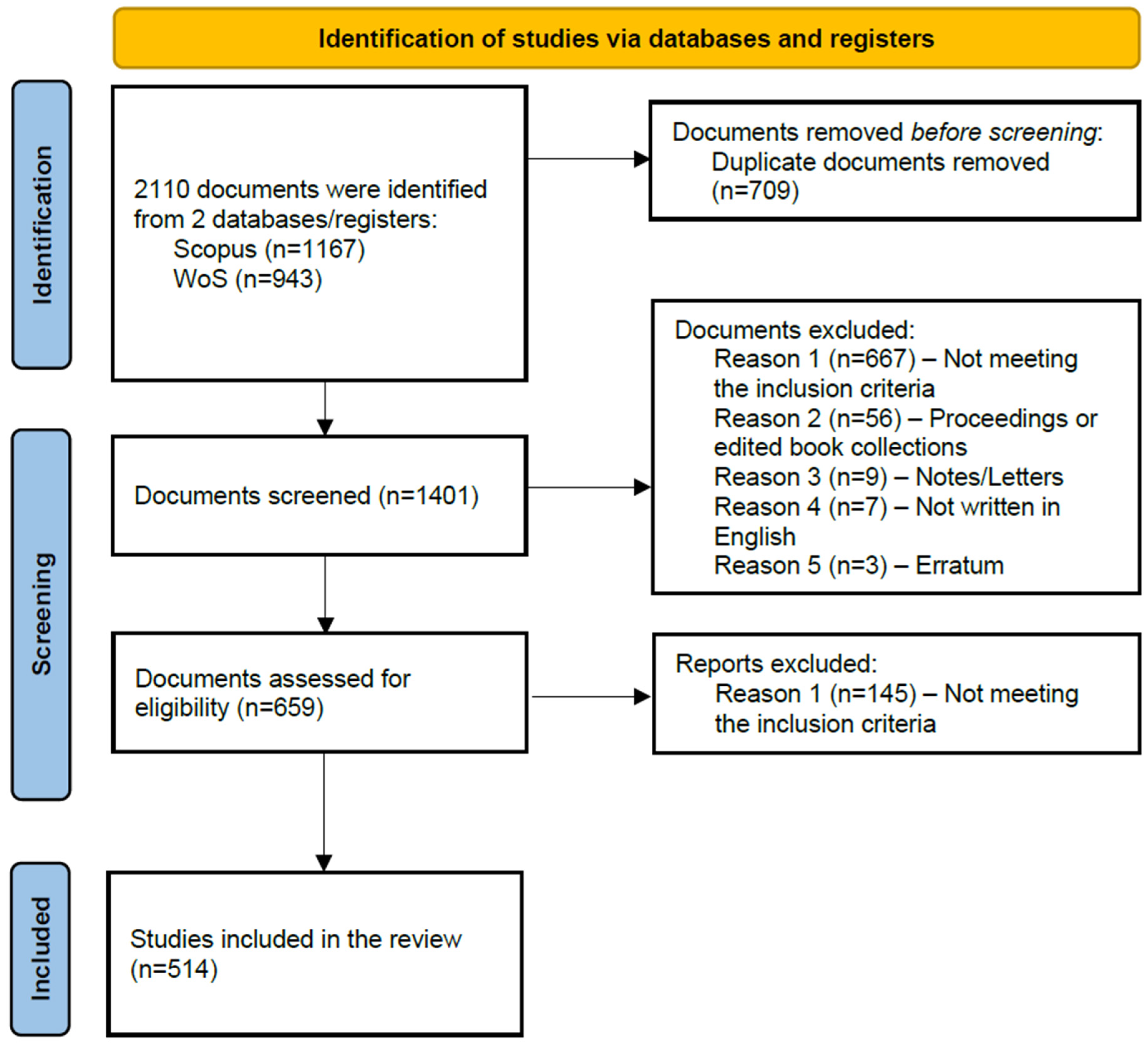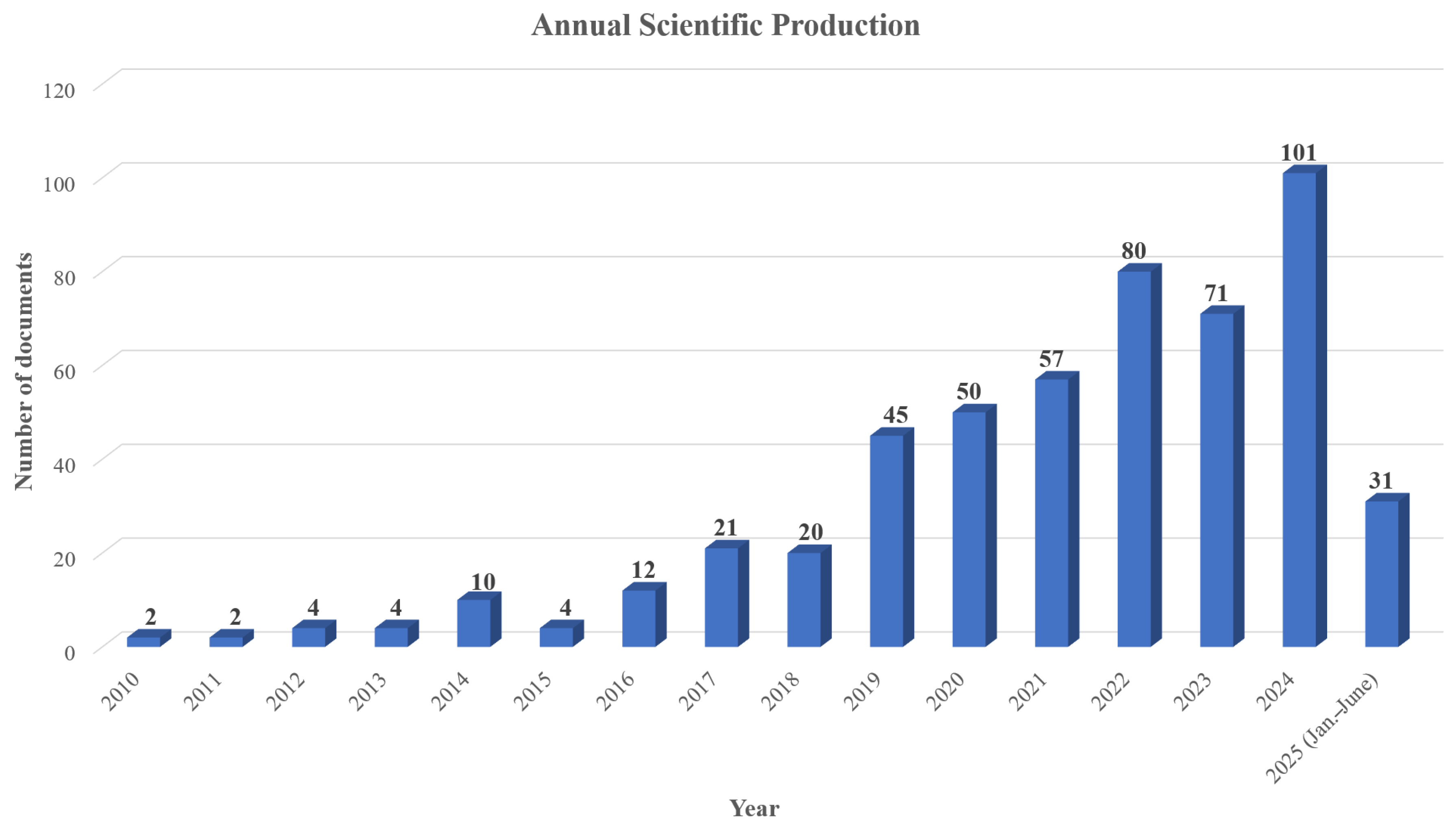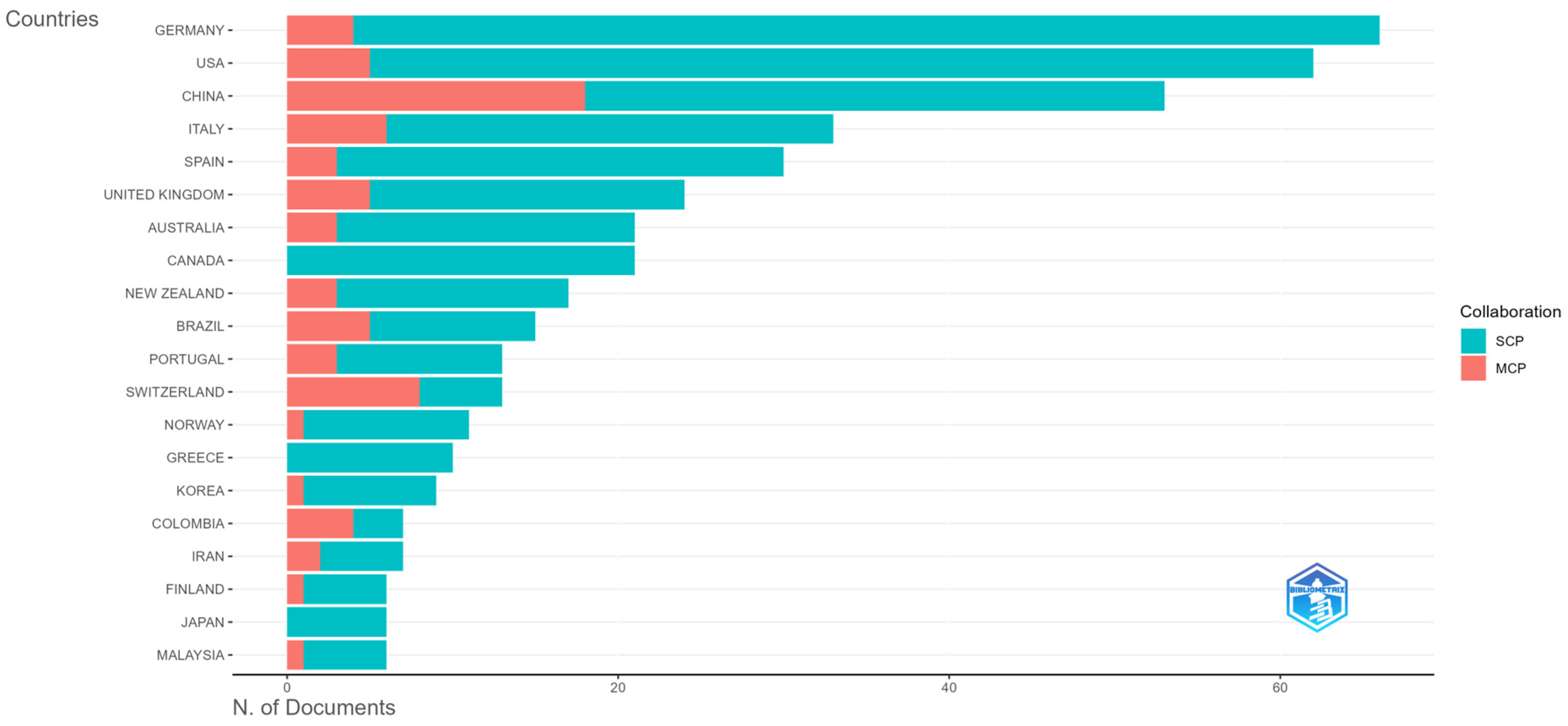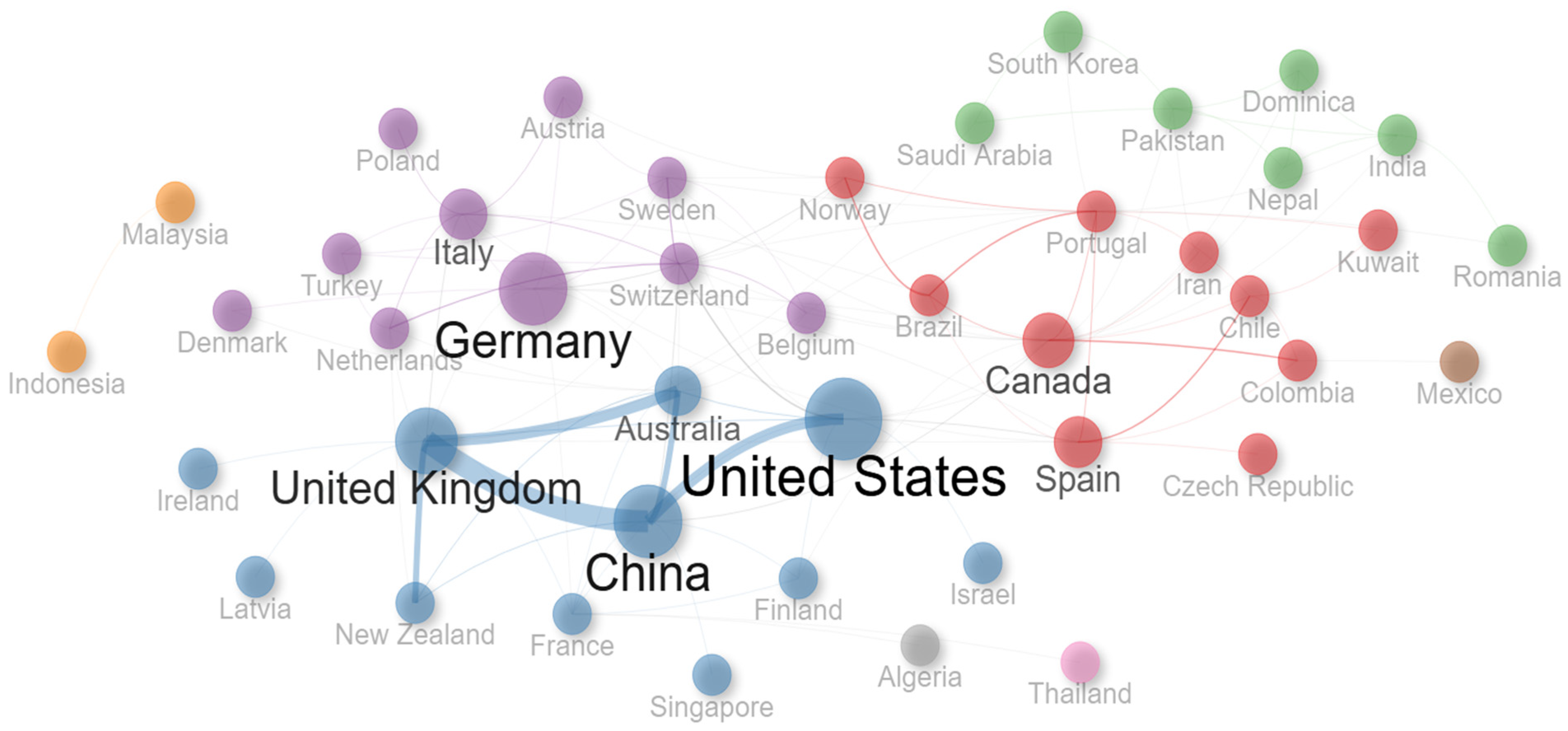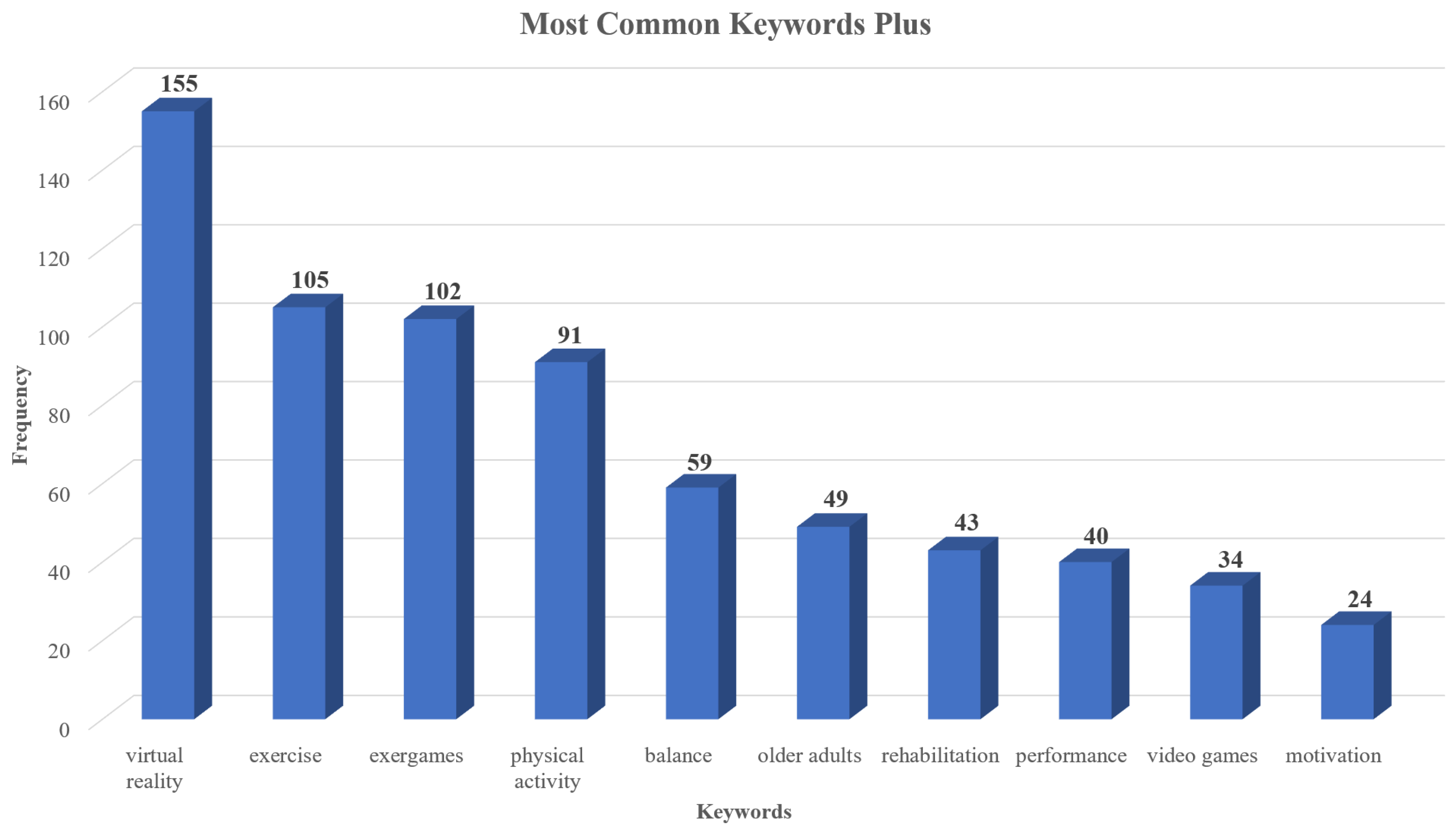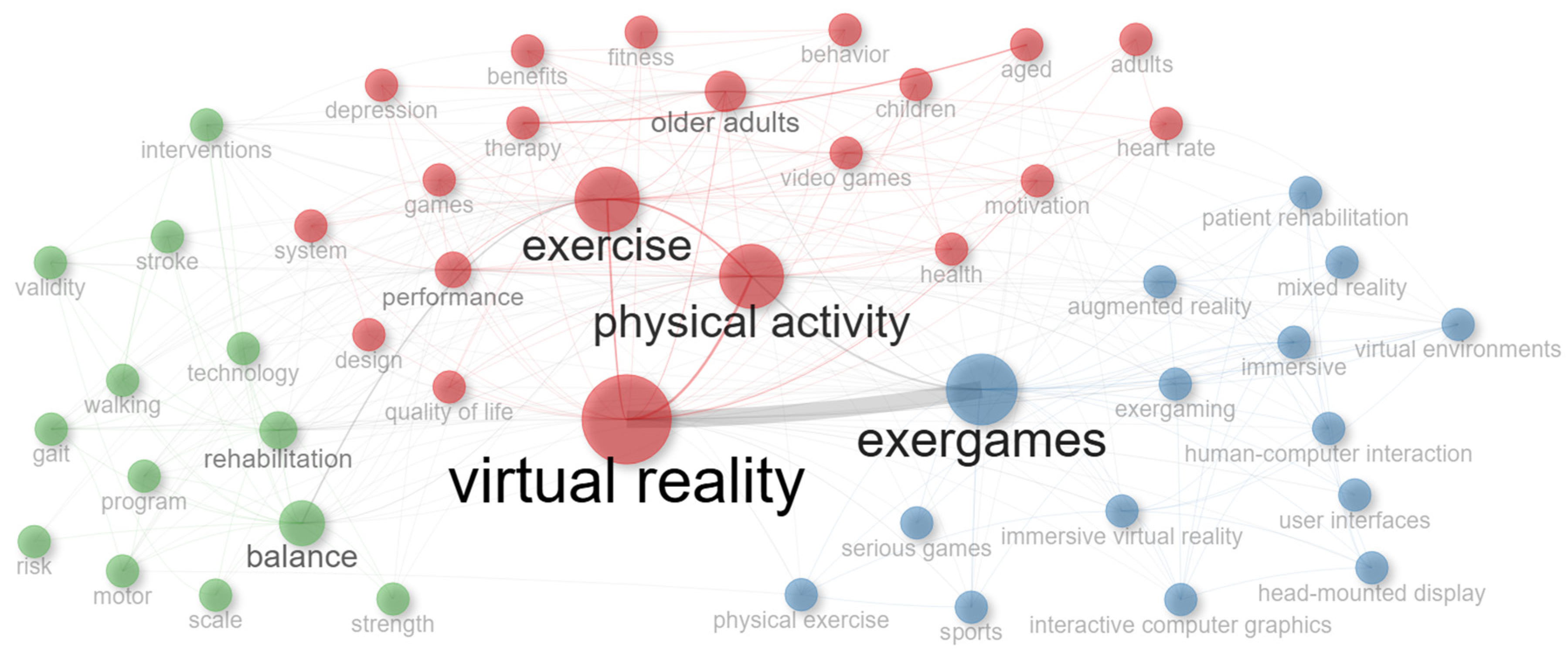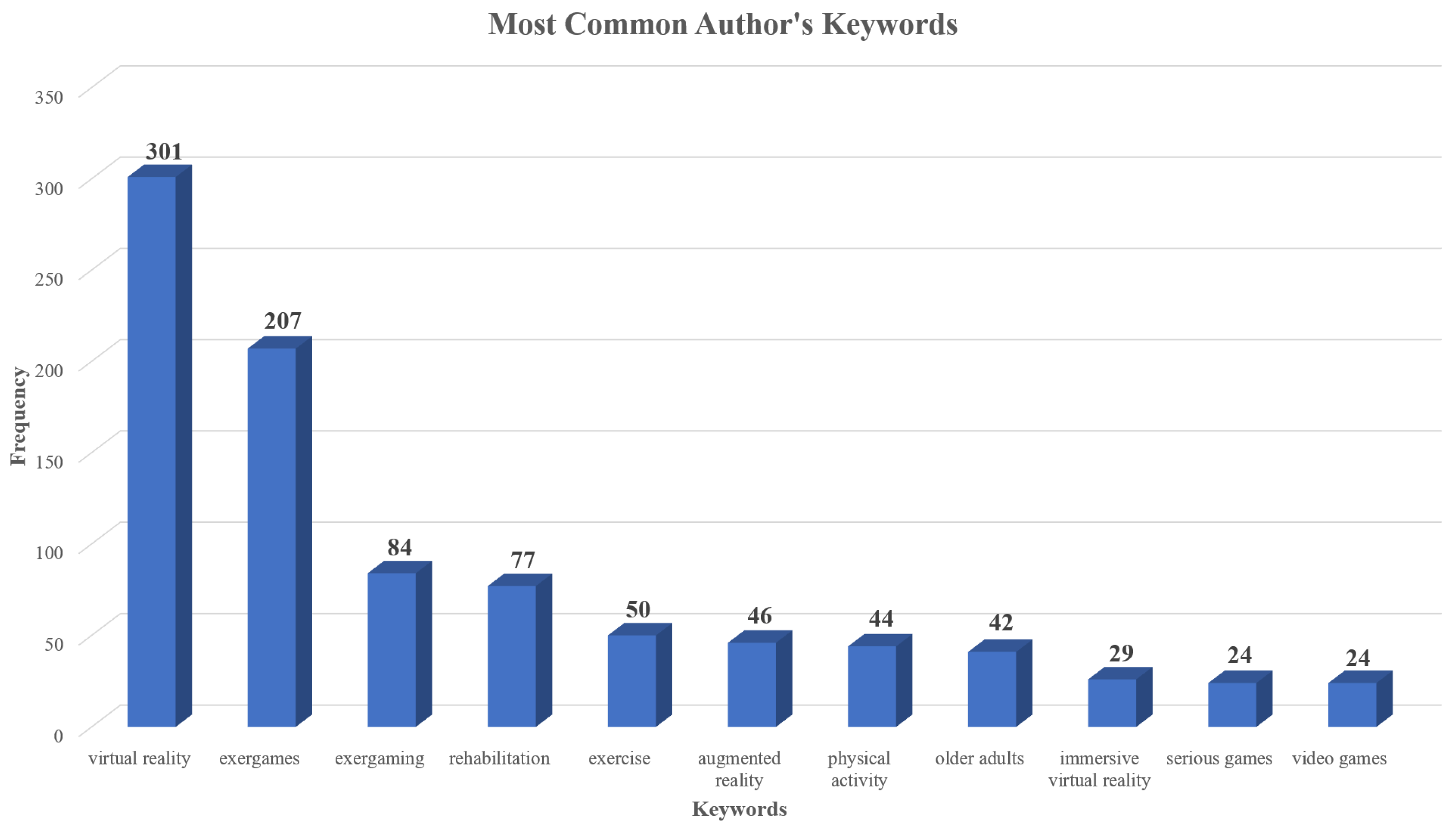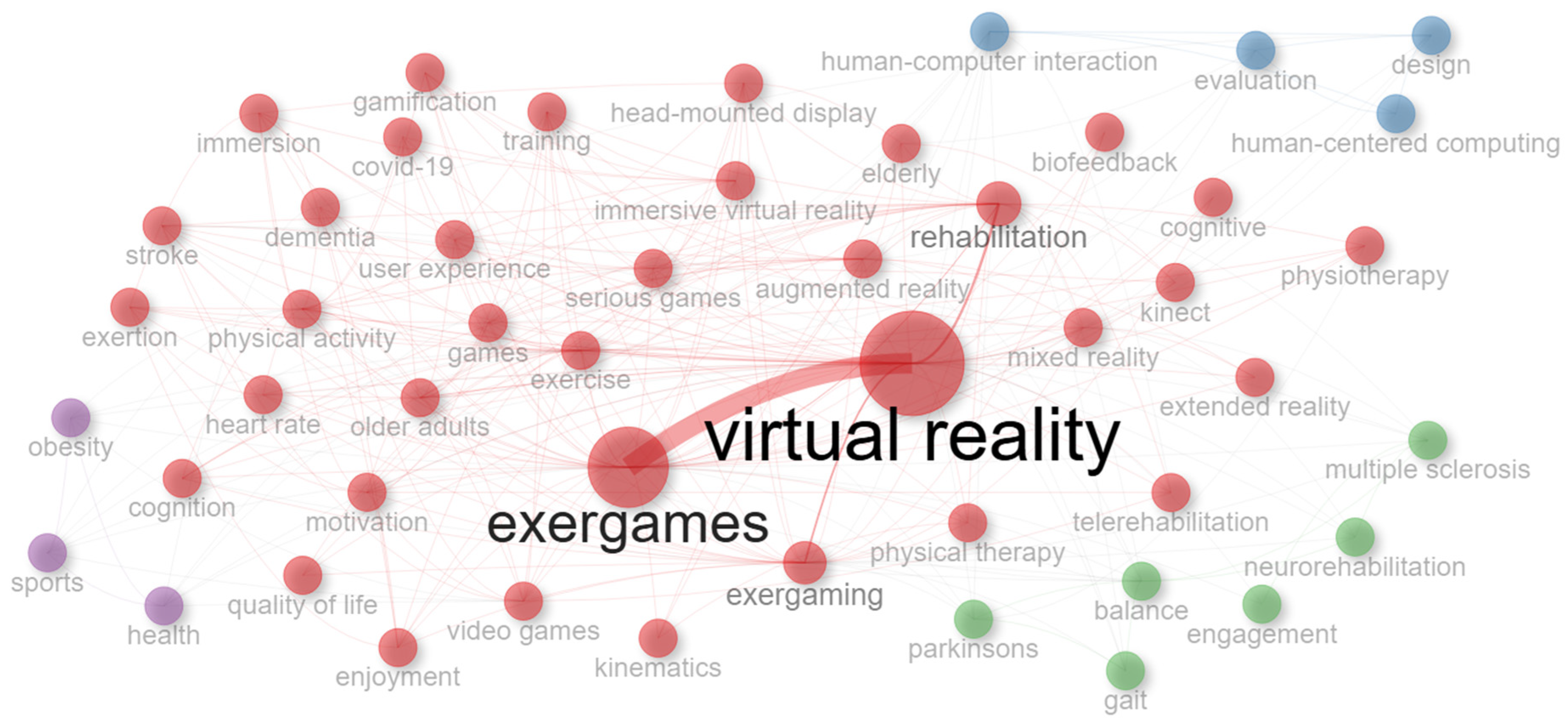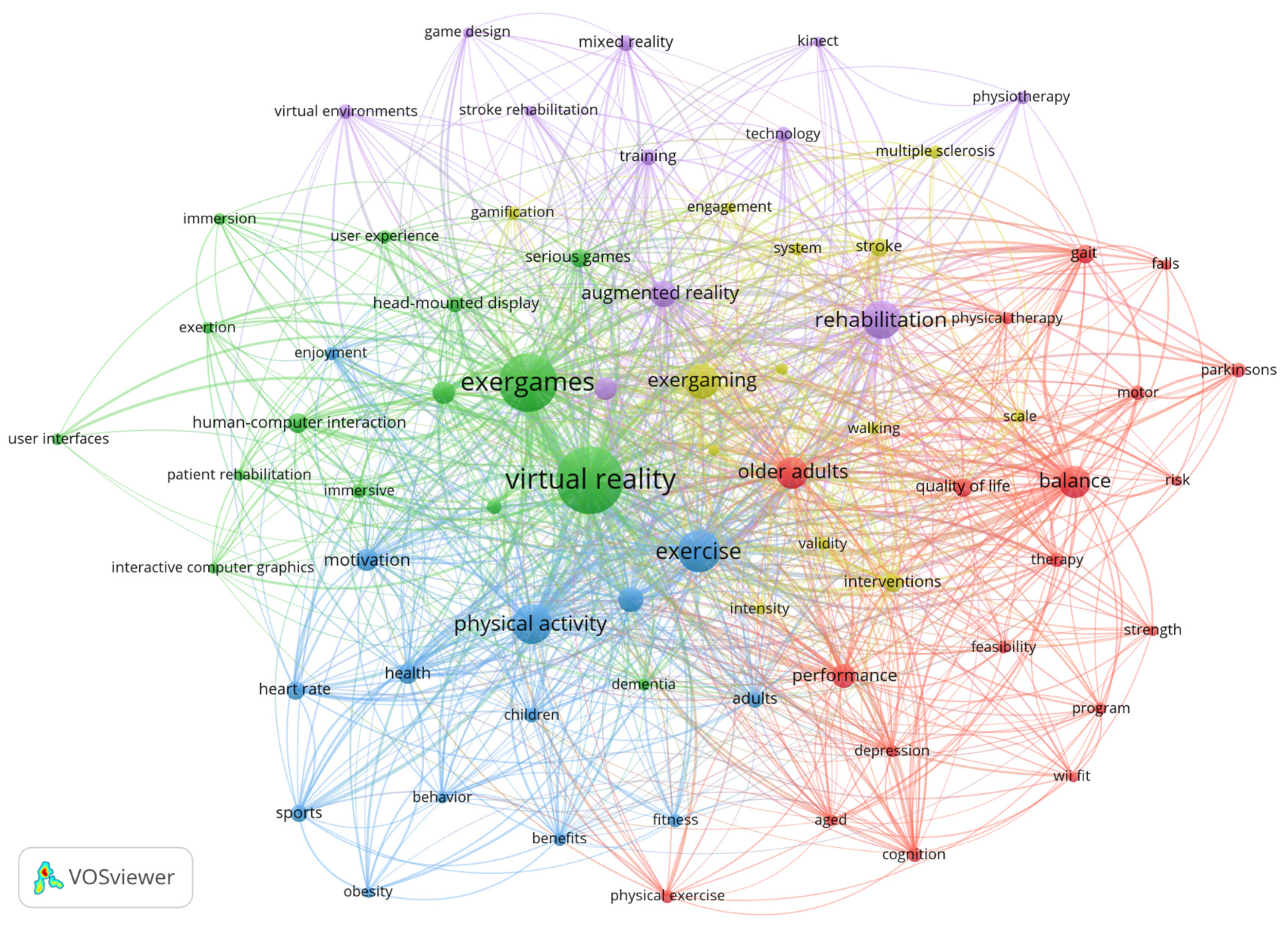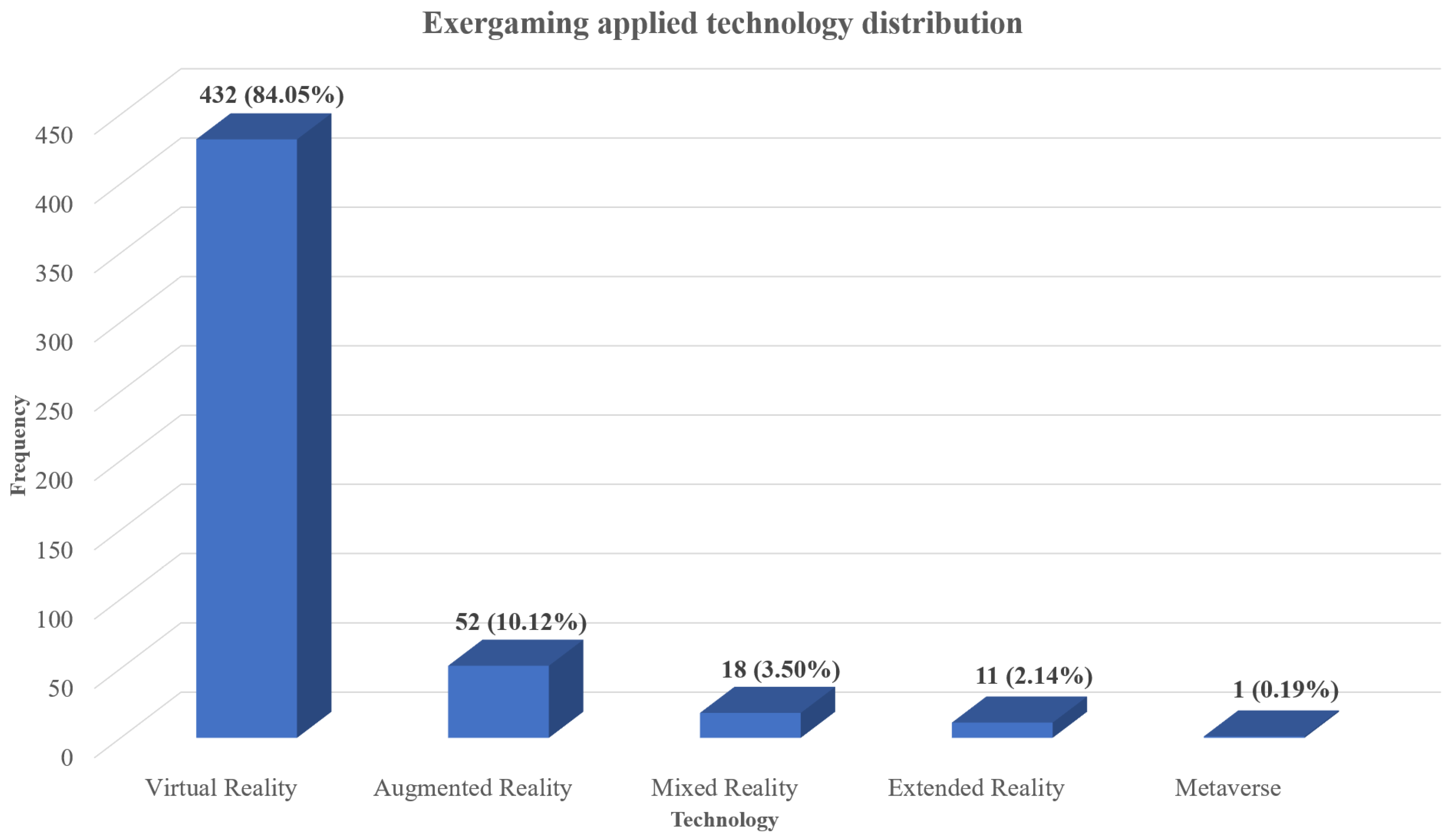1. Introduction
Exergames yield social, physical, and educational benefits and promote well-being [
1] and as such, they constitute an emerging field in the domains of health, fitness, and education [
2]. Exergaming blends physical activity with digital entertainment by engaging participants in interactive gameplay that requires bodily movements to control in-game actions; thus, resulting in a whole-body gaming experience. Due to the wide applicability of exergames and their potential benefits, the research regarding their adoption and integration is rapidly increasing.
Figure 1 presents the increase in the frequency of the keywords “exergames” and “exergaming” in academic papers in Google Scholar.
Additionally, exergames use gamification elements and promote meaningful play and as such, they are characterized by high levels of engagement and motivation, which influence psychological effects, including flow, enjoyment, and immersion [
3,
4,
5]. Exergames also have emotional implications as they can significantly affect individuals’ “happiness, anxiety, depressive symptoms, mental health-related quality of life, self-worth, self-esteem, self-efficacy, perceived behavioral control, vigor, vitality, intrinsic motivation, perceived energy, and relaxation” [
6].
In the context of exergaming, individuals can independently engage in unique exercise activities within safe environments that promote health and well-being through the use of interactive devices, such as Wii fit, Kinect sensor, etc. [
7,
8,
9]. These devices can enhance physical function, improve quality of life and cognition, and reduce depression and anxiety, particularly in older adults [
10,
11,
12].
Exergaming can bring about positive social effects, including attitudinal, behavioral, and emotional outcomes, and improved social well-being in older adults by increasing social connections, reducing loneliness, and improving positive attitudes toward others [
13]. Additionally, they can significantly improve individuals’ anthropometric measures, increase cognitive performance, enhance mental health-related quality of life, and reduce depressive symptoms [
14,
15]. Hence, participants express positive attitudes regarding the use of exergames, highly value the social interactions they offer, and consider them useful, enjoyable, and acceptable to increase their physical activity [
9,
16,
17,
18].
Furthermore, exergames support the training and motivation for sustainable physical activity, offer user-specific feedback and training programs, and provide personalized and playful exercises and activities for individuals of all ages [
19,
20]. Exergames promote light to moderate intensity physical activity [
21,
22] and improve access to physical activity for individuals with physical disabilities [
23]. They also offer moderate intensity physical activity in populations with neurological disabilities [
24], which can positively affect their cognitive functioning [
25].
Specifically, exergaming aids in rehabilitating motor skills in the context of Parkinson’s disease as it demonstrates reduced severity of motor symptoms and improved balance [
26]. It improves executive and motor abilities of children with attention deficit hyperactivity disorder (ADHD) and positively influences their psychopathology [
27,
28]. Exergames also enhance cognitive and executive functions, increase motor skills, and reduce repetitive behaviors for individuals with autism spectrum disorders (ASD) [
29,
30]. They can also yield benefits in terms of emotional, physical, and cognitive functions to individuals with dementia or mild cognitive impairment [
31,
32].
Moreover, exergames constitute a social activity that can increase the engagement of older adults in physical activities [
33], improve their health-related quality of life [
34], and facilitate their rehabilitation and exercise [
35]. Specifically, exergames can improve health in older adults as they can enhance older adults’ physical activity, improve their subjective happiness and mental well-being, and increase their motor skills and reaction time; hence, they are mostly being used in the context of wellness, rehabilitation, and training [
8,
36,
37]. Specifically, exergaming can be used as a supplementary approach that promotes physical activity and performance of balance exercises, which can increase older adults’ mobility, balance function, postural control, dual-task function, cognition, and confidence and reduce their fall risk [
20,
38,
39,
40,
41,
42]. Hence, it can be inferred that, although related to the duration and frequency of the interventions, exergames enhance balance dysfunction and executive function of older adults and are safe in neurological conditions [
43,
44].
In addition to the benefits exergames bring to adults and elders, they can also yield physical and cognitive health benefits for children and adolescents while simultaneously promoting healthier lifestyles through the active engagement in meaningful physical activities [
2,
45,
46]. As a result, and due to their physical and psychological effects, exergaming can also be used in educational settings to positively affect students’ flow, academic performance, and basic psychological needs [
47]. Through their strong motivational aspects, exergames increase students’ physical activity intensity and captivate their interest more in comparison to traditional fitness [
48,
49]. Particular emphasis is being placed on their use in physical education curriculum to enable students to develop, adapt, and monitor a fitness plan and to build healthy habits to engage in lifelong exercise [
50]. Therefore, exergaming is a promising addition to promote health and physical exercise, which can also lead to increasing physical activity levels and cardiometabolic health and to preventing or reducing childhood obesity [
51,
52,
53]. Among the various subjects, emphasis is being placed on their use in physical education, as they can enhance students’ physical health and also affect their visual-spatial skills, attention, self-esteem, motivation, and social interaction [
54] by supporting data-driven initiatives, measurements, adaptations, and decision-making [
55].
However, to fully reap the benefits of exergames and to create effective and safe therapeutic exergames, it is important to adopt suitable and robust design approaches when creating exergames and exergame-based interventions, provide follow-up support, include written and video instructions, and opt for age-appropriate challenges [
18,
56,
57,
58]. The competitive aspects associated with the use of exergames should also be carefully considered, as they might influence individuals’ state and performance [
59].
Extended reality (XR) technologies, such as augmented reality (AR) and virtual reality (VR), have shown great potential to be used in the context of exergames. Specifically, studies have shown that due to their immersive and interactive nature, these technologies can effectively be used in combination with gameful approaches to further enhance motivation and engagement [
60,
61], elements that are integral in exergaming. Additionally, studies have revealed that AR and VR exergaming go beyond entertainment [
62] and yield physical, psychological, and mental health benefits [
63,
64,
65,
66].
Specifically, AR blends the physical with the digital worlds by tracking and monitoring the physical environment and embedding dynamic and interactive content onto it [
67,
68]. Hence, AR provides new interactive and personalized ways for users to simultaneously interact with both the virtual and real environments [
69,
70]. Due to its traits, the use of AR has been examined across various contexts, including education [
71], training [
72], entertainment [
73], physical activity [
74], fitness [
75], healthcare [
63], mental health [
76], and rehabilitation [
77].
VR simulate users’ physical presence within virtual environments that are characterized by high levels of immersion, realism, and interaction [
78,
79,
80]. As, in VR environments, users can interact solely with the virtual content and not with the real environment, there is an increasing emphasis on users’ embodiment, interactions, and sense of presence within the virtual world [
81,
82,
83]. Similarly to AR, the use of VR is also widely examined in different domains, including, once again, education [
84], training [
85], entertainment [
86], physical activity [
87], fitness [
88], healthcare [
89], mental health [
90], and rehabilitation [
91].
These technologies have been reported to effectively support and enrich domains that are highly related to exergaming. Additionally, when following robust design approaches [
92,
93], both AR and VR can influence users’ affective states [
94,
95], promote their active involvement and motivation [
96,
97], offer personalized and adaptive experiences [
98,
99], and affect their cognitive, physical, and socio-emotional development [
60,
61]. Moreover, they create new possibilities for users to be engaged in meaningful physical activity. Hence, due to the potential benefits that they can bring in exergaming, the research surrounding their use in exergames across different domains and use cases is increasing.
Exergaming has become an increasingly popular tool to promote physical activity, rehabilitation, and cognitive engagement. Simultaneously, AR and VR technologies are advancing rapidly, offering new opportunities for more immersive and engaging exergaming experiences. These technologies hold significant promise across various domains, including healthcare, education, and entertainment. However, without a clear understanding of how AR and VR are currently being used in exergaming, it is difficult for researchers and developers to build effective, evidence-based applications. Despite the growing interest in exergames and the rapid development of XR technologies, there is a lack of comprehensive understanding of how XR is being applied within exergaming contexts. Existing studies vary widely in focus, making it difficult to identify consistent trends, challenges, and research gaps. Therefore, a systematic mapping of the current literature is needed to clarify the state of research and guide future development in this emerging area. Additionally, to the best of our knowledge, there has not been another scoping review study that examines this topic following similar approaches.
Consequently, this study presents a scoping review regarding the use of augmented reality and virtual reality in exergaming during 2010–2015. This study adopts a systematic approach and examines the existing literature to understand where the field stands, what kinds of applications have emerged, and which topics are gaining traction. It also looks into how AR and VR exergames are being used across different populations and settings, what benefits they offer, and what challenges exist. Finally, it highlights key limitations and gaps in the current research and suggests directions for future studies.
2. Materials and Methods
To provide a thorough, transparent, and reproducible analysis, this study adopted the Preferred Reporting Items for Systematic reviews and Meta-Analyses (PRISMA) framework, which is a standardized method for conducting and reporting systematic reviews and meta-analyses [
100], and used a scoping review approach with an emphasis on scientific mapping, bibliometric analysis, and topic modeling to examine the current literature. This approach is deemed effective to explore the current state of the art of broadly defined topics [
101,
102], as is the case for this study. Additionally, to better report the findings, the guidelines presented in recent studies were followed [
103,
104].
Given the rigor and credibility of Scopus and Web of Science (WoS), their being widely used in similar studies and being highly regarded, these two sources were selected as the databases to identify relevant studies [
105,
106]. Another reason was the ability to directly use the data retrieved in the tools selected in this study, since it is supported, without requiring further manual modifications [
104,
107], which could hinder the reproducibility and transparency of the study. To examine the studies from different dimensions, the Bibliometrix [
104] and VOSviewer [
107] tools were used to conduct the bibliometric and scientific mapping analysis of the related studies and to identify additional topics of interest, Latent Dirichlet Allocation (LDA) [
108] topic modeling was carried out.
The dataset was last updated on 1st July 2025. The query used to search for relevant studies was the following: (“virtual reality” OR “VR” OR “metaverse” OR “augmented reality” OR “AR” OR “mixed reality” OR “MR” or “extended reality” OR “XR”) AND (“exergam*”). The query ran on a topic level (title, abstract, and keywords) and did not involve any further limitations. To maintain a focused scope and ensure conceptual clarity, we limited our search to studies that explicitly used the term “exergam*”. Although not including other synonyms can be regarded as a limitation, it enabled the examination and representation of studies that were grounded specifically in the exergaming context. Additionally, other synonyms of exergaming have a more diverse scope and are used more broadly in the literature, which might have affected retaining a focused scope in this review. Finally, it should be noted that the use of abbreviations resulted in an increased number of studies reported, which were out of scope, but simultaneously ensured that all relevant studies would be identified.
The detailed analysis of the steps taken following the guidelines of the PRISMA framework is presented in
Figure 2. Specifically, in total, 2110 (Scopus: 1167 and WoS: 943) potentially relevant studies were identified. Given the scope of this study, the inclusion criteria set for a study to be included in this study were for it to be written in English, be a journal article, conference/proceedings paper, or book chapter, and focus primarily on the use of XR technologies, and/or the metaverse in exergaming. Throughout the identification and processing of the related studies, researchers individually carried out each of the steps presented and cross-checked their results. In case of differences, the outcomes were further discussed to ensure that the most appropriate course of action was taken. Initially, 709 studies were excluded as they were duplicates. Hence, 1401 studies were further processed by screening their titles and abstracts. A total of 667 studies were removed as they were out of the scope of this study and 75 more studies were excluded as 56 of them were conference/proceeding collections, 9 were notes or letters, 7 were not written in English, and 3 were errata. Following this step, the full text of 659 studies was examined. Taking the inclusion criteria into consideration, an additional 145 studies were removed as they did not primarily focus on the use of XR technologies or the metaverse in exergaming. Consequently, the document collection examined in this study consisted of 514 studies.
4. Discussion
Both AR and VR have shown great potential to enhance physical activity, exercise, physical performance, and psychological outcomes [
119] and improve the quality of life for both youth and older adults [
120]. Despite their several applications in the context of physical activity and exergames, immersive technologies are mostly being examined as a means to improve rehabilitation [
121] as they can support both home-based and remote rehabilitation [
122]. Due to their immersive, collaborative, and interactive nature, individuals showcase high levels of satisfaction and acceptance in using XR exergames to train their cognitive and motor skills [
123,
124].
By blending the virtual with the real environment, AR can create engaging and interactive experiences that encourage users’ bodily movement within the physical world which, in turn, can significantly increase their physical activity and functional fitness [
75,
125]. Additionally, due to the sense of presence that they offer, they can increase individuals’ focus, consistency, and involvement [
74] which, in turn, can enhance their self-efficacy, physical activity motivation, and performance [
126,
127]. It also showcases great potential in the context of exergaming with emphasis being placed on its use in physical and cognitive rehabilitation as it can create enjoyable and realistic experiences which motivate and engage individuals in exercising [
128,
129].
AR exergames can effectively be used for physical therapy [
130] and for improving mental health and well-being [
131,
132] as they can support, enrich, and assess physical and mental activities [
133]. AR exergames have the potential to enhance motivation and feedback, improve training and exercise, and increase muscle strength [
127,
134,
135]. They can also positively affect limb functionality, gait, balance, and fall prevention [
122,
130,
135,
136,
137]. However, emphasis should be placed on their design, on providing multimodal feedback, and on considering the target groups’ requirements and needs [
129,
136,
138,
139,
140].
VR has also shown great potential to enrich physical activity [
87] and to improve individuals’ psychological, physiological, performance, and rehabilitative outcomes [
141,
142]. In the context of exergaming, the immersive embodiment and personalization that VR exergames offer can positively affect individuals’ performance, physical functions, perceived exertion, and motivation [
143,
144,
145,
146,
147]. Specifically, VR exergames can enhance fitness, health, and well-being [
148,
149] and are positively viewed by stakeholders [
150,
151].
Given the advancements in the field of wearable technologies, VR can further promote physical activity while enabling full-body motions and controls [
152,
153,
154]. Using various head-mounted devices and sensors [
116,
155], VR exergames can also effectively enhance physical and cognitive rehabilitation [
156,
157,
158,
159]. They can be used in conjunction with artificial intelligence technologies to further increase their potential [
160].
VR exergames can offer several physical and cognitive benefits while reducing depression, perceived stress, and anxiety and as such, they can be used in different health-related contexts [
115,
161,
162,
163]. Additionally, they can be effectively used for therapeutic and treatment purposes [
164] as they can improve physical and mental health [
165] and offer psychological benefits [
166]. They also positively affect mood, executive functions, cognitive performance, and visual-motor skills from youth to older adults [
115,
167,
168,
169,
170,
171,
172].
VR exergames can create enjoyable, interactive, and high-intensity physical activities and exercises within virtual and safe environments that promote achievement, engagement, and motivation [
96,
173,
174,
175]. Hence, they can increase the quality and frequency of physical activity [
118,
176,
177] and promote active lifestyles and healthy habits [
178]. VR exergames have physical and psychological impacts and can influence cognitive and functional outcomes, mobility outcomes, gait, fall prevention, and balance self-efficacy [
179,
180,
181,
182,
183]. They can also improve the physical-psychological health, physical activity, and quality of life of individuals even during unprecedented time periods, such as the COVID-19 pandemic [
177,
184,
185].
VR exergaming can result in individuals showcasing increased enjoyment and motivation, enhanced physiological outcomes [
186], and improved concentration and consistency [
187]. Besides individual experiences, VR exergames offer social and collaborative experiences which further increase enjoyment, experiences, motivation, and outcomes, particularly during rehabilitation [
188,
189,
190].
However, there are technological, individual, and organizational facilitators and barriers to consider when applying VR exergame solutions [
191]. Additionally, as there are several challenges associated with the design and development of effective VR exergames [
192], emphasis should be placed on individuals’ characteristics [
193,
194] and the holistic design of such experiences and environments, e.g., design choices, complexity, the medium used, and usability, as they can influence individuals’ involvement and outcomes [
195,
196]. Hence, to create effective exergames that positively influence individuals, it is important to adopt participatory design approaches and engage different stakeholders throughout the design and development stages [
197,
198,
199].
4.1. Topic Analysis-Keyword Analysis
Furthermore, this study placed emphasis on identifying the topics present within the analyzed document collection. To achieve this, a thematic analysis was performed using multiple elements of each document, including keywords plus, author keywords, titles, and abstracts. To carry out the keyword analysis both Bibliometrix and VoSviewer were used. Based on
Figure 6, the most frequent keywords plus were “virtual reality”, “exercise”, “exergames”, “physical activity”, “balance”, “older adults”, “rehabilitation”, “performance”, “video games”, and “motivation”. Using Bibliometrix, the co-occurrence network of keywords plus was created. Three clusters (
Figure 7) emerged, which were related to the following:
Blue cluster: adults, aged, behavior, benefits, children, depression, design, exercise, fitness, games, health, heart rate, motivation, older adults, performance, physical activity, quality of life, system, therapy, video games, and virtual reality.
Red cluster: augmented reality, exergames, exergaming, head-mounted display, human-computer interaction, immersive, immersive virtual reality, interactive computer graphics, mixed reality, patient rehabilitation, physical exercise, serious games, sports, user interfaces, and virtual environments.
Green cluster: balance, gait, interventions, motor, program, rehabilitation, risk, scale, strength, stroke, technology, validity, and walking.
Moreover, according to
Figure 8, the most frequent author keywords were “virtual reality”, “exergames”, “exergaming”, “rehabilitation”, “exercise”, “augmented reality”, “physical activity”, “older adults”, “immersive virtual reality”, “serious games”, and “video games”. Using Bibliometrix, the co-occurrence network of author keywords was developed. Four clusters (
Figure 9) arose, which were related to the following:
Red cluster: augmented reality, biofeedback, cognition, cognitive, COVID-19, dementia, elderly, enjoyment, exercise, exergames, exergaming, exertion, extended reality, games, gamification, head-mounted display, heart rate, immersion, immersive virtual reality, kinect, kinematics, mixed reality, motivation, older adults, physical activity, physical therapy, physiotherapy, quality of life, rehabilitation, serious games, stroke, telerehabilitation, training, user experience, video games, and virtual reality.
Green cluster: balance, engagement, gait, and multiple sclerosis.
Blue cluster: design, evaluation, human-centered computing, and human-computer interaction.
Purple cluster: health, obesity, and sports.
To obtain a better representation of the topics contained within the collection, keywords plus and author keywords were further examined jointly using VoSviewer. It is important to note that when a keyword appeared in both keywords plus and author keywords for a given study, it was counted only once to avoid duplication. The most frequent keywords with the highest link strength were virtual reality (total link strength = 1322), exergames (total link strength = 990), exercise (total link strength = 668), physical activity (total link strength = 561), and rehabilitation (total link strength = 550). The related outcomes of the keywords with a total link strength of at least 100 are presented in
Table 7. Additionally, the co-occurrence network created via VOSviewer based on all keywords, which can be seen in
Figure 10, consisted of five clusters that were related to the following:
Red cluster: “aged”, “balance”, “cognition”, “depression”, “falls”, “feasibility”, “gait”, “motor”, “older adults”, “parkinson”, “performance”, “physical exercise”, “physical therapy”, “program”, “quality of life”, “risk”, “strength”, “therapy”, and “wii fit”.
Green cluster: “dementia”, “design”, “exergames”, “exertion”, “head-mounted display”, “human-computer interaction”, “immersion”, “immersive”, “immersive virtual reality”, “interactive computer graphics”, “patient rehabilitation”, “serious games”, “user experience”, “user interfaces”, and “virtual reality”.
Blue cluster: “adults”, “behavior”, “benefits”, “children”, “enjoyment”, “exercise”, “fitness”, “health”, “heart rate”, “motivation”, “obesity”, “physical activity”, “sports”, and “video games”.
Yellow cluster: “active video games”, “engagement”, “exergaming”, “gamification”, “intensity”, “interventions”, “intrinsic motivation”, “multiple sclerosis”, “scale”, “stroke”, “system”, “validity”, and “walking”.
Purple cluster: “augmented reality”, “game design”, “games”, “kinect”, “mixed reality”, “physiotherapy”, “rehabilitation”, “stroke rehabilitation”, “technology”, “training”, and “virtual environments”.
LDA was also used to identify relevant topics based on the study titles and abstracts. The results of the LDA were cross-checked, compared with, and examined along with those of the keyword analysis. Hence, by combining the outcomes of both LDA and the keyword analysis, nine broad topics were defined. These topics are presented in alphabetical order below:
Biofeedback, sensor, and monitoring systems;
Children and youth populations;
Cognitive and mental health support;
Educational, training, and skill-based exergaming;
Fitness, performance enhancement, and physical activity promotion;
Motivation and engagement;
Older adults and neurological populations;
Rehabilitation, physical therapy, and clinical;
Well-being and healthy habits.
4.2. Related Studies Analysis
Furthermore, to obtain a better understanding of the impact of AR and VR in exergaming, the studies, which received the most citations and are showcased in
Table 6, are further examined. van der Kolk et al. [
110] investigated whether aerobic exercise could be safely and effectively performed at home by people with mild Parkinson’s disease through the use of a VR exergame intervention. Participants in the intervention group used a stationary bike equipped with virtual environments and real-life video simulations to create an exergaming experience. Based on their results, the participants who exercised within the immersive environment showed a greater improvement in motor symptoms compared to those who performed traditional stretching exercises. While some participants experienced mild or unrelated side effects, the intervention was generally safe. The study suggested that home-based exercise through the use of VR exergames can constitute a feasible and promising option. Anderson-Hanley et al. [
111] examined the use of VR exergames to enhance older adults’ cognition. The study revealed that older adults who used VR exergaming showed better brain function and mental flexibility compared to those doing regular exercise. The improvement in cognitive performance seemed linked to changes in brain chemistry that support brain health. These users were also less likely to show early signs of memory decline. The outcomes of the study suggest that combining physical and mental activity through VR exergames may be more effective than traditional exercise alone for supporting brain health in older adults.
Focusing on VR, Skjæret et al. [
35] examined how VR exergames can influence older adults’ rehabilitation and exercise by analyzing 60 related studies. The study revealed that mostly commercially available solutions are adopted and that safety measures are used during interventions. Based on their outcomes, no serious adverse events were observed; however, few studies commented upon the existence of adverse events. Based on their outcomes, the use of VR exergames resulted in positive outcomes in terms of the participants’ gait and balance while, simultaneously, no negative effects were reported. Nonetheless, the PEDro classification revealed that the examined studies had several methodological limitations. Hence, the study pointed out the need for more experimental studies to occur that use robust and well-defined guidelines to successfully establish the use of VR exergames as part of older adults’ rehabilitation and exercise. Fleming et al. [
112] explored how gameful approaches, including VR and exergames, are being used to support mental health. They highlighted that these formats are among the key categories of applied games with promising potential for therapeutic benefit. Their findings suggested that such interventions can utilize game mechanics to enhance user engagement and may facilitate positive psychological outcomes. However, the authors also emphasized the need for further research to better understand their effectiveness and to compare them with traditional approaches. Gandolfi et al. [
113] examined the use of VR telerehabilitation to improve balance and mobility in people with Parkinson’s disease. Participants in the VR group trained at home using exergames with remote supervision, while a comparison group received traditional in-clinic balance training. Both groups showed overall improvements, but the VR group made greater gains in balance, while the in-clinic group showed more improvement in gait performance. These findings suggest that home-based VR exergame training can be a practical and cost-effective option for enhancing balance and mobility in Parkinson’s patients, particularly when caregiver support is available.
Focusing on improving older adults’ physical functioning, Molina et al. [
114] conducted a systematic literature review of 13 related studies. In their study, they examined the most commonly used exergame interventions and assessment instruments. Although positive outcomes were generally reported and there was a shared consensus about the motivational benefits associated with the use of exergames, a great variety in the study settings was observed and according to the PEDro classification, methodological issues were observed, which hindered the generalizability of the results. Therefore, the study highlighted the need for more experimental studies to be conducted to provide stronger scientific evidence and external validity regarding the impact of VR exergames on older adults. Yen and Chiu [
115] put emphasis on improving older adults’ cognition and depression through the use of VR exergaming. Through their systematic literature review and meta-analysis, they highlighted that VR exergames have moderate positive effects on older adults’ function and memory and greatly reduce their depressive outcomes. Additionally, they pointed out that higher intervention duration resulted in more favorable outcomes. Therefore, the outcomes of this study suggest that besides an increase in participants’ activity engagement and interactions, VR exergames can also positively influence older adults’ memory, depression, and cognition.
Furthermore, Borrego et al. [
116] compared different VR devices in the context of exergaming, exploration, navigation, and rehabilitation. Specifically, they put emphasis on their technical capabilities and their feasibility to be used for health-related applications. Their results revealed that head-mounted devices can effectively be used within VR environments for exergaming, rehabilitation, navigation, and exploration purposes. However, the devices used can influence users’ experience and outcomes. In their study, Bolton et al. [
117] presented their VR cycling exergame. Specifically, they highlighted the potential of using VR in conjunction with sensors and haptic devices to enhance users’ physical activity experiences. Finally, they commented how immersive exergaming experiences that fully immerse and engage users can be created through this approach. Similarly, Finkelstein et al. [
118] presented and assessed their immersive VR exergame, which focused on encouraging users to be involved in rigorous, full-body exercise. The exergame was positively viewed by the participants who varied in age, background, and skills. Their results highlighted that VR exergames can motivate both children and adults to actively exercise within immersive environments.
4.3. Outcomes and Implications
Exergaming can effectively be used in various domains. As immersive technologies advance, there has been an increased interest in the use of AR and VR in exergaming. By using AR and VR technologies in the context of exergaming, new immersive and interactive experiences can be created which, in turn, can further amplify the positive physical, cognitive, and emotional outcomes associated with traditional exergaming. Specifically, the adoption and integration of AR and VR into exergaming represents a notable advancement in the health sciences domain with a growing body of evidence supporting its potential benefits. By combining XR technologies with exergames, game-like, engaging, and immersive experiences can be created, which can transform traditional physical activity and render it more interactive, motivating, and enjoyable. These experiences have the potential to yield significant physiological and psychological benefits, establish foundational health habits, and promote sustainable health behaviors.
Due to their nature, XR exergames can be used by users of all ages. As a result, within the document collection examined, there has been an increased interest in their use and effects on older adults. However, studies have also explored their impact on adults and, to a lesser extent, on children and youth. Emphasis has also been placed on how XR exergames can affect neurological populations and individuals with disabilities. Based on the related outcomes, it can be inferred that the use of immersive exergames can be applied across individuals’ developmental stages offering positive effects on physical activity, engagement, and cognitive functioning, and promoting well-being.
These immersive exergames support the use of advanced biofeedback, sensor, and monitoring systems that can personalize the experiences to meet the needs and capabilities of each individual. As studies have indicated, XR exergames can improve individuals’ cognitive functions and mental health while promoting and enhancing their engagement, active involvement, and motivation. Immersive exergaming showcased great potential to promote physical activity and fitness, enhance physical performance, and encourage a healthy and active lifestyle. Among the various use cases of XR exergaming, it is mostly being applied in the context of rehabilitation, physical therapy, and clinical applications. However, there is also growing interest in their use for educational purposes and skill development. In all cases, XR exergaming promotes healthy habits and well-being.
Furthermore, according to the outcomes, the integration of AR and VR into exergaming constitutes a feasible and promising way for individuals to engage in home-based and remote-based physical activities [
110,
113,
200] which offer therapeutic benefits [
112]. Specifically, by combining XR technologies with exergames, immersive, engaging, interactive, and data-driven experiences that dynamically adapt to individuals’ state, needs, and abilities can be created [
115,
117]. These experiences contain motivational aspects that motivate and promote the active involvement of individuals of all ages [
112,
114,
118]. Hence, individuals of different ages, backgrounds, and skills express positive views regarding the use of immersive exergames [
118].
Individuals who exercise using immersive exergames demonstrate increased motor functions, brain function, and mental flexibility compared with those who use traditional methods [
110,
111,
113]. Additionally, they showcase increased gait and balance [
113], enhanced positive psychological outcomes [
112], reduced depressive outcomes, and improved cognition, function, and memory [
111,
115]. However, it should be noted that the design of the experience, the device used [
116], and the duration of the intervention can influence outcomes, as individuals who participate in higher duration interventions demonstrate more favorable outcomes [
115]. Therefore, it can be inferred that the combination of physical and mental activity through XR exergames can be more effective than traditional exercise alone.
The relationship between XR-based exergaming and the broader field of digital medicine, which is “
poised to transform biomedical research, clinical practice and the commercial sector” [
201], should also be considered. Both areas capitalize on emerging technologies to support health and well-being, but their goals and contexts of use often differ. Digital medicine capitalizes on advanced technologies, such as artificial intelligence, machine learning, and big data analytics, to support the diagnosis, treatment, and management of disease, typically involving clinical oversight and targeting specific patient populations [
202]. Given its scope and nature, digital medicine heavily relies on interoperability and data integrity [
203]. On the contrary, XR exergaming primarily aims to promote physical activity, engagement, and general well-being, often among healthy individuals. While it may be used for prevention and rehabilitation purposes, its core design typically emphasizes accessibility, enjoyment, and motivation rather than clinical outcomes. This distinction between promoting health in healthy individuals and treating illness in patients highlights different priorities in design, evaluation, and implementation.
Finally, it is important to note that although the studies generally reported positive outcomes, there was a significant disparity in the types of technologies adopted. Specifically, the overwhelming majority of studies focused on exploring the use of VR in exergaming (n = 432, perc. = 84.05%). Fewer studies examined the use of AR in exergaming (n = 52, perc. = 10.12%) while significantly fewer studies focused on mixed reality (n = 18, perc. = 3.50%) and XR (n = 11, perc. = 2.14%). Only a single study (0.19%) explored exergaming within the metaverse. The related outcomes can also be seen in
Figure 11.
The predominance of VR in exergaming research can be attributed to its technological maturity, wide availability, and ability to provide fully immersive and controlled environments. These qualities make VR especially suitable for experimental designs, clinical applications, and rehabilitation settings where consistency and standardization are essential. Despite its promising potential, AR has received considerably less attention in exergaming research compared to VR. This limited focus can be attributed to several factors, including the technological challenges of AR deployment, such as device compatibility, reliance on real-world environments, and variability in the settings of physical environments. Additionally, AR applications often require more complex development to integrate physical activity with real-time environmental overlays. The lack of established AR exergaming platforms and fewer commercial tools compared to VR have also contributed to its underrepresentation in the literature, despite its unique advantages, such as increased accessibility, lower cost, and the potential for seamless integration into everyday environments. However, this technological disparity limits the generalizability of findings and highlights a critical research gap. The limited exploration of AR, mixed reality, XR, and metaverse applications highlights the need for broader investigation into these emerging platforms, particularly given their unique features and advantages.
5. Conclusions
The outcomes of this study highlight the potential of AR and VR technologies to further enhance the effectiveness and scope of exergaming. The outcomes revealed a significant increase in the interest in and the scientific production of this field, which has attracted global interest over the last years. However, a consistently sustained interest in the field rather than a spontaneously emerging or short-lived research trend was observed which highlights its significance. The use of only two databases, the examination of English documents only, and the use of only the keyword “exergam*” in the query can be regarded as the limitations of this study.
Based on the outcomes, AR and VR exergaming can create interactive, immersive, engaging, and personalized experiences that promote physical, cognitive, and emotional well-being. Additionally, they provide safe environments for low, mid, and high-intensity physical activity, with high embodiment and enhanced feedback mechanisms that support enjoyable physical activity and foster achievement, engagement, and motivation. Hence, they promote active lifestyles and sustainable health habits and behaviors, offering physical and mental health outcomes across diverse populations, including older adults, individuals with disabilities, and neurological groups, as well as the general adult and youth populations.
Moreover, XR exergaming demonstrates potential in improving physical functions, performance, perceived exertion, motivation, concentration, and consistency. It can enhance fitness and functional outcomes while positively affecting quality of life. The combination of immersive embodiment, real-time biofeedback, and personalized training offers measurable psychological, physiological, and cognitive benefits. In addition to individual gains, XR exergaming can also provide social and collaborative experiences that increase enjoyment and engagement.
AR and VR exergames have various applications across different domains, including therapeutic, clinical, rehabilitative, and preventative ones. Particular emphasis is placed on their use in physical and cognitive rehabilitation, where immersive exergames improve mobility, gait, balance, fall prevention, self-efficacy, limb functionality, and muscle strength. Additionally, they can reduce depression, perceived stress, and anxiety, while simultaneously improving mood, executive functioning, cognitive performance, visual-motor skills, and overall physical and psychological well-being.
Despite their potential benefits, there are challenges and issues that need to be further explored and addressed. These are related to long-term effects, infrastructure, cost, and standardized protocols and guidelines. User safety and accessibility are important aspects that should be further examined. There are also ethical considerations and data security and privacy concerns that need to be addressed. Finally, the physical demands placed on users should be carefully considered.
Future research should focus on large-scale, longitudinal studies to evaluate long-term effects and transferability to real-life, sustainable, and long-term engagement in physical activity. There is also a need for interdisciplinary collaboration to create effective design standards and guidelines and optimize user experience across age groups and physical abilities. Additionally, the development of validated evaluation measurements and tools specific to XR exergaming is essential to advance evidence-based practice. As the current literature is limited by the lack of adequately powered, high-quality randomized controlled trials, particularly in relation to long-term outcomes and sustainability, to validate their effectiveness and clinical relevance, future studies should prioritize well-designed experimental studies with rigorous methodologies, clearly defined outcome measures, and longitudinal follow-ups. Finally, it is important for future studies to compare the outcomes of XR exergaming with traditional interventions.
Based on and in contrast to the current literature that focuses on exergames in general, there is a clear lack of focus on other domains of XR exergames besides their use in rehabilitation. For example, the research regarding the use of AR and VR exergames in educational contexts remains limited. Specifically, immersive exergames could enhance education by promoting engagement, motor skill development, and cognitive stimulation. Their ability to integrate physical and mental challenges renders them a promising educational approach to support diverse learners and promote lifelong healthy habits and well-being.
All in all, AR and VR exergaming present great potential for health promotion and therapeutic applications. They offer immersive, evidence-based interventions that foster well-being, enhance motivation, and yield physical and mental health outcomes. However, continued development and rigorous evaluation are essential to better understand their efficacy, address current limitations, and guide their responsible integration into mainstream health and educational practices.
